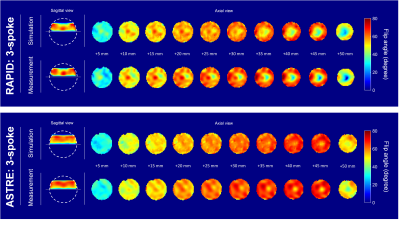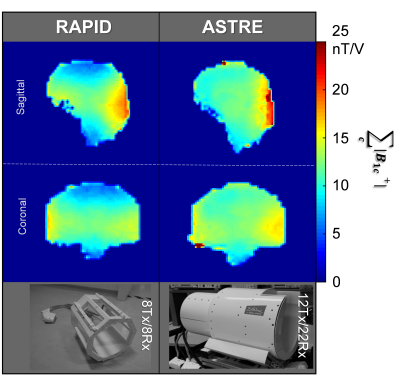3398
Z-segmentation of a transmit array head coil improves RF ramp pulse design for TOF MRA at 7T1CEA/DRF/Joliot/NeuroSpin/UNIRS, Gif-sur-Yvette, France, 2Siemens Healthineers France, Saint-Denis, France, 3CEA/DRF/IRFU/DACM, Gif-sur-Yvette, France, 4Laboratoire des Signaux et Systèmes, Université Paris-Saclay/CentraleSupélec/CNRS, Gif-sur-Yvette, France
Synopsis
In Time-Of-Flight sequences, ramp pulses such as TONE are frequently used to compensate for thru-slab blood saturation in cerebral MRA. At Ultra High Field, parallel transmit fast-kz spokes can be used to greatly mitigate B1+ heterogeneities in the slab selection process. Here we use this technique to design TONE pulses with improved flip angle ramp fidelity and compare the performance achieved with a homemade z-segmented head coil versus a non-segmented commercial array.
INTRODUCTION
Time-Of-Flight (TOF) sequences suffer from blood saturation (BS) effects precluding the visualization of the entire arterial vasculature of the brain1. Several studies demonstrated that crescent flip angle (FA) profile excitations compensate this effect in the slab direction2, 3. For TOF imaging, 7T MRI has a clear advantage as compared with 3T in terms of SNR and contrast4, but suffers for B1+ heterogeneities which hamper reaching the targeted ramp profiles uniformly throughout the brain. So far fast-kz spokes have proven useful to homogenize slice or slab profiles, especially in conjunction with parallel transmission (pTx)5. In this work, the pTx spokes technique is used to design TONE pulses that provide the desired linear FA ramp profile throughout the brain. The impact of a pTx coil array segmentation along the slab direction (z) is sought by comparing the performances of the implied RF weight optimizations with two head arrays: a 8-Tx/Rx RAPID head array (RAPID Biomedical GmbH, Rimpar, Germany) with purely azimuthally-distributed resonators, and a homemade z-segmented coil (12Tx/22Rx “ASTRE” coil which includes 1 Tx/Rx circularly polarized patch close to the top of the head and 11 Tx/Rx azimuthally-distributed dipoles segmented in two rows along the z-direction6).MATERIALS & METHODS
Experiments were performed on a 28 years-old healthy volunteer using a 7T scanner (MAGNETOM, Siemens Healthcare, Erlangen, Germany). Different spoke pulses were optimized to select a variable FA pattern from 10° to 40° in a 50-mm slab located in the upper part of the brain, which is highly impacted by BS effects. The spoke excitations were composed of three identical but weighted sub-pulse waveforms played at optimized (kx, ky)-locations. The k-space encoding matrix in the Small Tip Angle approximation was built using the 3-D B0 and B1 maps acquired with a 5-mm resolution on the same volunteer in both coils. Joint optimization of (kx, ky)-locations and complex RF weights for each channel and spoke was performed under SAR and power constraints7, 8. The maximum peak amplitude per channel was set to 160V for both coils. Power constraints were fully relaxed by increasing the TR to 1000ms and the sub-pulse duration to 3ms to proceed to a fair comparison. In this context, the optimization was formulated in a Magnitude Least Squares problem minimizing the RMS error from a constant FA, the target at the center of the slab (25°), while a predesigned ramp waveform applied to the weighted spokes took care of the desired linear slice profile. This TONE waveform was obtained by multiplying the desired ramp by the frequency response of an apodized SINC pulse with time-bandwidth product TBW = 10, and by inverse Fourier transforming the resulting product. As a circumstantial study, the previous optimization criterion was modified to evaluate the potential of the coil segmentation alone in solving the FA ramp problem. In this case, the uniform FA target was changed into the 3D FA ramp pattern, and a conventional SINC waveform was simply applied at each spoke for slab selection. Thus, the ramp profile was directly formulated in the optimization problem with no need for a TONE waveform. All FA profiles and ramp RMS errors (normalized to 25°) were computed with a full Bloch simulation under Matlab. Prior to this study, FA measurements were performed with an AFI sequence9 on a phantom to validate the FA patterns returned by the Bloch simulation (Figure 1).
RESULTS & DISCUSSION
Figure 2 compares the sum of B1 magnitudes available for transmission for both RF coils. Thanks to its three transmit segments along z, ASTRE offers a better potential for controlling the FA profile in that direction. Thus, replacing the uniform FA target by the desired FA pattern in the optimization almost succeeded in generating the desired profile without using a ramp excitation waveform, which was impossible to perform using the RAPID coil (Figure 3). This test validated the intrinsic ease of z-segmented coils to generate the desired ramp profile. Furthermore, the 3-spoke transmission with TONE sub-pulse shapes outperformed the RF shim for both coils. As expected the NRMSE and slab profile were significantly improved with the ASTRE in comparison to the RAPID coil (Figure 4, Table 1).CONCLUSION
Z-segmented transmit coils facilitate the TONE desired ramp profile useful to compensate the BS effects in off-centered locations for TOF at 7T. Yet non segmented coils can still perform ramp profiles provided adequate RF waveforms. Then kz-spokes were proved useful to improve in-plane homogeneity with such ramp pulses.Acknowledgements
No acknowledgement found.References
1. Schmitter S, Wu X, Auerbach EJ, Adriany G, Pfeuffer J, Hamm M, et al. Seven-Tesla Time-of-Flight Angiography Using a 16-Channel Parallel Transmit System With Power-Constrained 3-dimensional Spoke Radiofrequency Pulse Design: Investigative Radiology. 2014 May;49(5):314–25.
2. Atkinson D, Brant-Zawadzki M, Gillan G, Purdy D, Laub G. Improved MR angiography: magnetization transfer suppression with variable flip angle excitation and increased resolution. Radiology. 1994;190(3):890–4.
3. Priatna A, Paschal CB. Variable angle uniform signal excitation (VUSE) for three dimensional time-of-flight MR angiography. Journal of Magnetic Resonance Imaging. 1995;5(4):421–7.
4. Von Morze C, Xu D, Purcell DD, Hess CP, Mukherjee P, Saloner D, et al. Intracranial time-of-flight MR angiography at 7T with comparison to 3T. Journal of Magnetic Resonance Imaging. 2007 Oct;26(4):900–4.
5. Setsompop K, Wald LL, Alagappan V, Gagoski B, Hebrank F, Fontius U, et al. Parallel RF transmission with eight channels at 3 Tesla. Magnetic Resonance in Medicine. 2006 Nov;56(5):1163–71.
6. Amadon A, et al. Comparison between commercial RF head coils and a new hybrid transmit-array coil based on 12 transmit elements and 22 receive elements for an 8-channel transmission system at 7T. Proceedings ISMRM 2016, Singapore
7. Dupas L, Massire A, Amadon A, Vignaud A, Boulant N. Two-spoke placement optimization under explicit specific absorption rate and power constraints in parallel transmission at ultra-high field. Journal of Magnetic Resonance. 2015 59-67
8. Hoyos-Idrobo A, Weiss P, Massire A, Amadon A, Boulant N, et al. On variant Strategies to solve the MLS Optimization Problem in Parallel Transmission Pulse Design and Under Strict SAR and Power constraints. IEEE Transactions on medical imaging, VOL. 33, NO. 3, MARCH 2014
9. Yarnykh VL. Actual flip-angle imaging in the pulsed steady state: A method for rapid three-dimensional mapping of the transmitted radiofrequency field. Magnetic Resonance in Medicine. 2007 Jan;57(1):192–200.
10. Amadon A, Cloos MA, Boulant N, Hang M-F, Wiggins CJ, and Fautz H-P, Validation of a very fast B1-mapping sequence for parallel transmission on a human brain at 7T, p. 3358, ISMRM 2012, Melbourne.
11. Smith SM. Fast robust automated brain extraction. Human Brain Mapping, 17(3):143-155, November 2002.
Figures


Figure 2. Sum of Tx-channel B1+ magnitudes for the RAPID and ASTRE coils. The individual B1 maps were acquired with the XFL sequence10 on the same volunteer for each coil. The maps were masked using the Brain Extraction Tool11 to focus the pulse design on the brain only.


